THE GENITIVE CASE IN RUSSIAN
In this lesson, you will learn how to use the Genitive Case, which is one of the most common and useful cases in the Russian language.
There are many things to learn in this lesson, so to make things easier, I divided it into 4 parts:
- How to put nouns into the Genitive Case;
- When and how to use the Genitive Case;
- Adjectives in the Genitive Case;
- Possessive Pronouns in the Genitive Case.
If you already know any of these topics, you can go straight to the subject you need to learn by clicking on the titles in blue.
In this lesson, we won’t talk about plural nouns and adjectives in the Genitive Case because we already have a complete lesson about this subject here at Mighty Russian.
If you already know how to use the Genitive Case in the singular, you can go straight to the next lesson:
NOUNS IN THE GENITIVE CASE
If you don’t know yet what cases are, they are basically special endings that we add to a word to indicate its function in a sentence.
In the Genitive Case, for example:
- The word мама becomes мамы.
- The word брат becomes брата.
- The word платье becomes платья.
There are several situations in which you are going to use the Genitive Case in Russian, but first let’s learn what endings you will have to add to nouns when using this case.
Changing, or declining, a noun is actually very simple. You just have to memorize a few rules.
You will notice that these rules will depend on the gender of the noun. The concept of gender in the Russian language is often new for native English speakers.
If you would like to learn more about gender in Russian, you can check out our complete lesson about it clicking here.
First, you can check out all the rules you will need for the Genitive Case in the table below. Then, I will exmplain them one by one.
Feel free to take a screenshot of the table and even print it out, so you can use it in your studies later.
To make things easier, I divided all the rules into 4 patterns:
01) Letter “А”
Add “А” to masculine nouns that end in a consonant:
друг – друга (friend)
брат – брата (brother)
стол – стола (table)
кот – кота (cat)
When neuter nouns end in “О”, replace “О” with “А”:
письмо – письма (letter)
лето – лета (summer)
окно – окна (window)
02) Letter “Я”
When masculine nouns end in “Й” or “Ь”, replace these letters with “Я”:
музей – музея (museum)
герой – героя (hero)
учитель – учителя (teacher)
строитель – строителя (builder)
When neuter nouns end in “Е”, replace “Е” with “Я”:
платье – платья (dress)
поле – поля (field)
03) Letter “Ы”
When nouns end in “А”, replace “А” with “Ы”, regardless of the gender:
мама – мамы (mother)
газета – газеты (newspaper)
папа – папы (father)
There is one important detail in this situation. You will add “И” instead of “Ы”, if the last consonant of the word is “Г”, “К”, “Х”, “Ж”, “Ч”, “Ш” or “Щ”.
For example:
книга – книги (book)
рука – руки (hand)
вилка – вилки (fork)
удача – удачи (luck)
крыша – крыши (roof)
This spelling rule is used in many other situations in Russian, not only in the Genitive Case. Therefore, memorizing these 7 letters will be very useful.
As you practice, you will also notice that it’s much easier to pronounce the letter “И” than the letter “Ы” after these consonants.
04) Letter “И”
When feminine nouns end in “Ь” or “Я”, replace these letters with “И”:
кровать – кровати (bed)
ночь – ночи (night)
неделя – недели (week)
And those were all the patterns you will use in the Genitive Case.
Besides nouns, we also have Genitive Pronouns. You will need them when the context is clear and you don’t want to repeat words.
Now let’s take a look at when you should use the Genitive Case.
WHEN AND HOW TO USE THE GENITIVE CASE
We will use the Genitive Case in 6 situations:
- To indicate possession
- To indicate quantity
- After measure words
- To indicate part of a substance or liquid or an indefinite quantity
- After the negative word “нет” to mean that something doesn’t exist or is absent
- After specific prepositions
Let’s go over each of these situations.
01) TO INDICATE POSSESSION
Have you ever noticed that when we want to say someone is the owner of something in English, we use an apostrophe plus “s”?
In Russian, you will express the same idea by using the Genitive Case.
Here are some examples:
книга мальчика (the boy’s book)
тетрадь Маши (Masha’s notebook)
машина мужа (the husband’s car)
Note that it’s always the possessor that takes the Genitive Case and that, in Russian, the possessor comes after the possessed object, unlike in English.
02) TO INDICATE QUANTITY
We will use the Genitive Case after numerals, such as 2,9,14 or 25.
For example:
два друга (two friends)
четыре человека (five people)
три ручки (three pens)
In Russian, we use the Genitive Singular after the numbers 2, 3 and 4, and the Genitive Plural for all the rest of the numbers.
But keep in mind that you will use the Genitive Singular not only when the numbers 2, 3 and 4 are alone, but also when a number ends with them. Except for 12, 13 and 14.
I know this can be very confusing at the beginning, but with time and practice, you will naturally be able to use the Singular and Plural Genitive correctly.
To make things easier, let’s take a look at some examples.
You will use the Genitive Singular after the numbers 2, 3, 4, 22, 23, 24, 32, 33, 34, 42, 43, 44, etc.
And you will use the Genitive Plural after the numbers 5, 7, 9, 11, 12, 13, 16, 25, 26, 27, 35, 38, 39, 45, etc.
So even if you have, for example, the number 10,523, you will use the Genitive Singular because it ends with the number “3”.
Again, I know it’s complex, but you will get used to it.
We also use the Genitive Case with quantifiers. The most common ones are “мало” (few / little), “много” (a lot of), “несколько” (several), “сколько” (how many / much).
For example:
мало денег (little money)
сколько часов (how many hours)
несколько человек (some people)
Note that the endings in these examples are a little bit different from the ones we just learnt. That’s because these nouns are in the plural and the Genitive Plural has different endings.
You can check out our lesson on the Genitive Plural clicking here.
03) AFTER MEASURE WORDS
After measure words, such as чашка (cup), тарелка (plate), бутылка (bottle) , кусок (slice), литр (liter) etc.
For example:
чашка чая (a cup of tea)
литр молока (a liter of milk)
4) TO INDICATE PART OF A SUBSTANCE OR LIQUID OR AN INDEFINITE QUANTITY
In English, when we are talking about an indefinite quantity or about part of something, we usually add the word “some” before the noun.
In Russian, however, you don’t need to add any word. Using the noun in the Genitive Case is enough.
For example:
Он попил молока (He drank some milk)
Она поела торта (She ate some cake)
5) AFTER THE NEGATIVE WORD “НЕТ” TO MEAN THAT SOMETHING DOESN’T EXIST OR IS ABSENT
When we want to say that something doesn’t exist or is absent, in English, we usually use the structures “there isn’t” and “there aren’t”.
In Russian, all you have to do is use the word “нет” plus the noun in the Genitive Case.
For example:
Дома нет воды (There is no water at home)
Здесь нет света (There is no light here)
06) AFTER SPECIFIC PREPOSITIONS
After certain prepositions, you always have to use the Genitive Case.
This part may also seem complicated, but you don’t have to try and memorize all the prepositions at once. Instead, try to learn them slowly as you practice your Russian.
Here are some examples:
После урока (After the lesson)
Из магазина (From the shop)
Без телефона (Without the cellphone)
Напротив дома (Opposite the house)
Около реки (Near the river)
У окна (By the window)
And those were all the situations in which you will use the Genitive Case. Now, let’s take a look at the adjectives.
ADJECTIVES IN THE GENITIVE CASE
Adjectives in the Genitive Case are much simpler than nouns because there are very few endings to memorize.
When it comes to adjectives, the most important thing is to pay attention to the gender of the nouns they describe.
In Russian, nouns have 3 genders: Masculine, Feminine and Neuter.
The ending of the adjective depends on the gender of the noun.
Here is a table with all the endings.
Let’s take a look at when to use each of these endings.
Adjectives with masculine nouns
1) Replace the endings “ЫЙ” and “ОЙ” with “ОГО”:
новый телефон – нового телефона (a new cellphone)
большой дом – большого дома (a big house)
молодой человек – молодого человека (a young person)
2) Replace the ending “ИЙ” with “ЕГО”:
синий карандаш – синего карандаша (a blue pencil)
хороший брат – хорошего брата (a good brother)
горячий шоколад – горячего шоколада (hot chocolate)
Note that when the last consonant of the adjective is “К” or “Х”, the adjective takes the ending “ОГО” instead of “ЕГО”:
русский человек – русского человека (a Russian person)
тихий вечер – тихого вечера (a quiet evening)
маленький ребёнок – маленького ребёнка (a little child)
Adjectives with neuter nouns
Neuter adjectives take the same endings as masculine adjectives.
1) Replace the ending “ОЕ” with “ОГО”:
новое платье – нового платья (a new dress)
большое окно – большого окна (a big window)
тихое море – тихого моря (a quiet sea)
2) Replace the ending “ЕЕ” with “ЕГО”:
хорошее лето – хорошего лета (a good summer)
синее небо – синего неба (a blue sky)
летнее платье – летнего платья (a summer dress)
Adjectives with feminine nouns
1) Replace the ending “АЯ” with “ОЙ”:
новая квартира – новой квартиры (a new apartment)
русская девушка – русской девушки (a Russian girl)
большая комната – большой комнаты (a big room)
Note that when the last consonant in the adjective is “Ч”,“Ш”, “Щ” “Ж” and “Ц” and the last syllable is NOT stressed, the adjective takes the ending “ЕЙ” instead of “ОЙ”:
свежая капуста – свежей капусты (a fresh cabbage)
горячая вода – горячей воды (hot water)
хорошая сумка – хорошей сумки (a good purse)
2) Replace the ending “ЯЯ” with “ЕЙ”:
зимняя ночь – зимней ночи (a winter night)
синяя футболка – синей футболки (a blue t-shirt)
поздняя попытка – поздней попытки (a late try)
POSSESSIVE PRONOUNS IN THE GENITIVE CASE
The Possessive Pronouns that you are going to use in the Genitive Case are:
The situations in which you will use these pronouns are exactly the same as the ones you have just learnt, but now you will also be indicating that someone is the owner of something.
For example:
Я всегда покупаю сладости для своего сына (I always buy sweets for my son)
Она нашла работу для твоей сестры (She found a job for your sister)
У нашего кузена много машин (Our cousin has many cars)
And that’s all.
Now you know when the Genitive Case is used and how to use it with nouns, adjectives and possessive pronouns in the singular.
Also don’t forget to check out our complete lesson about the Genitive Case in the Plural.
I hope everything got clear, but if you have any questions, just leave them in the comment section below.
I will be very happy to help you!

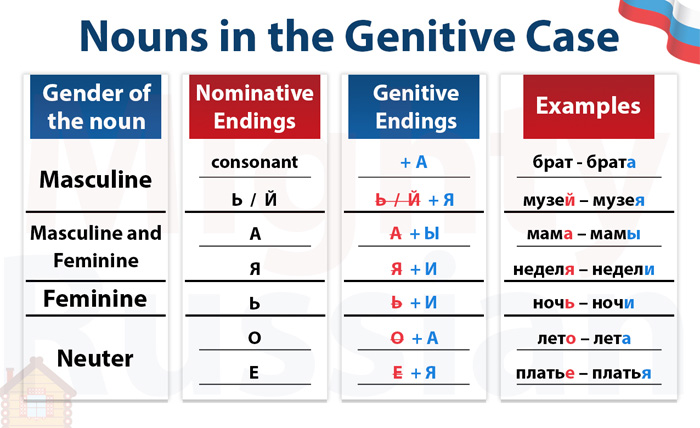
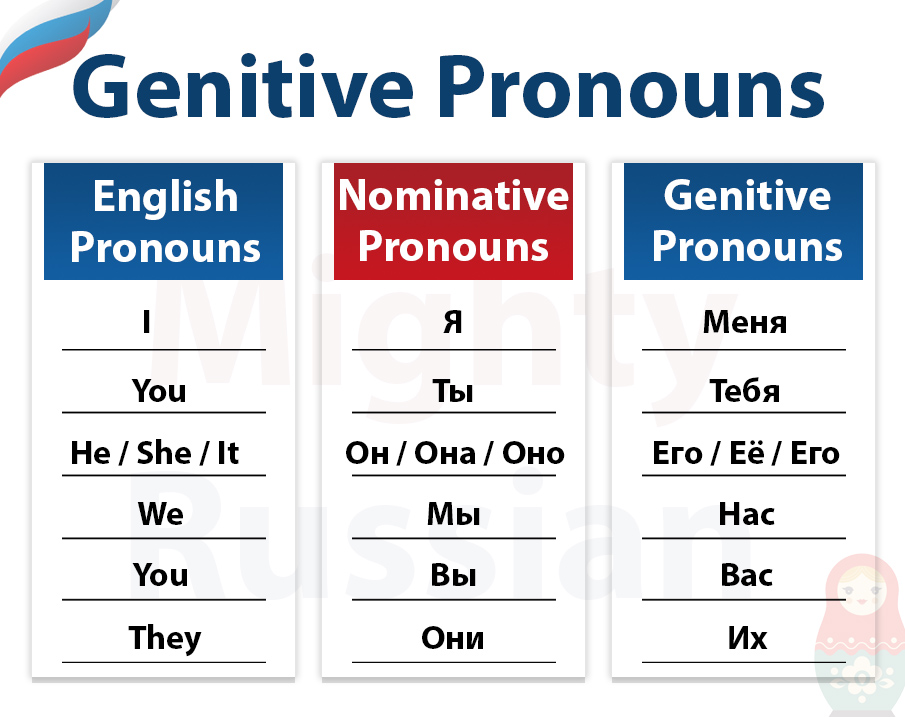

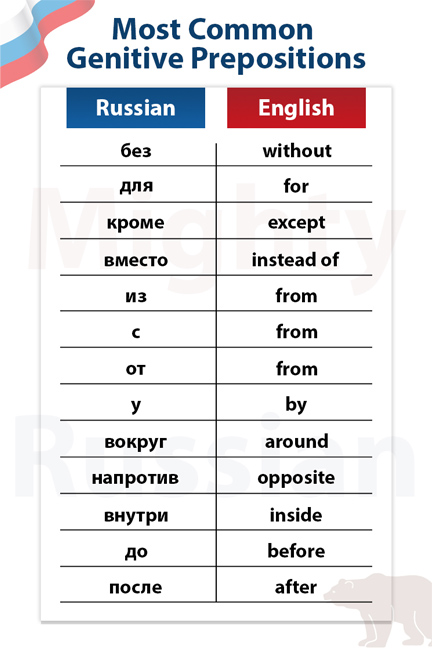
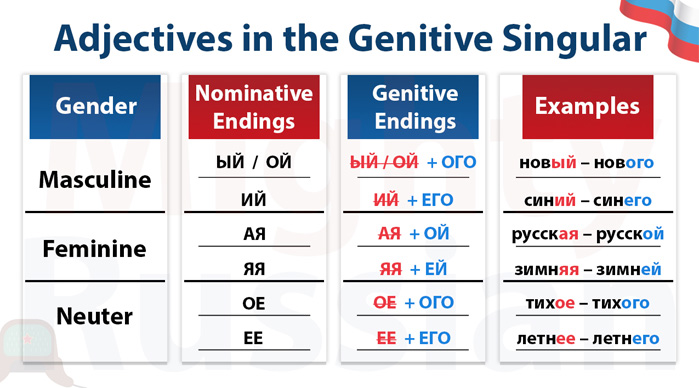
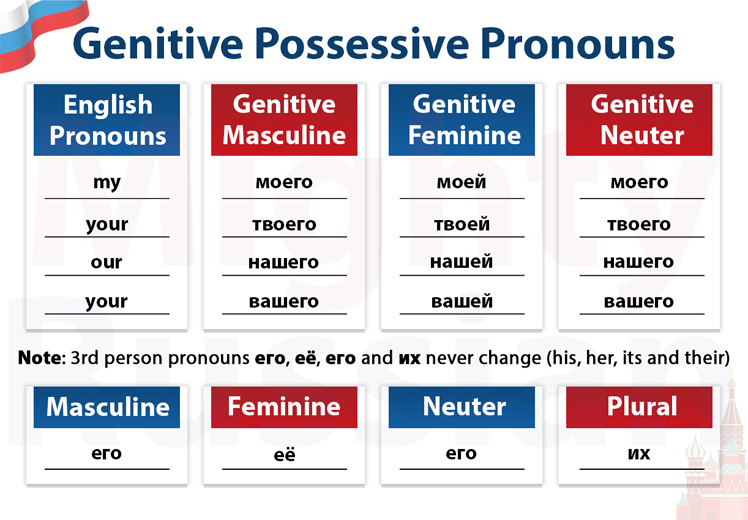











Молодец Настя🙏 спасибо💐
чеыре человека (“five” people)?